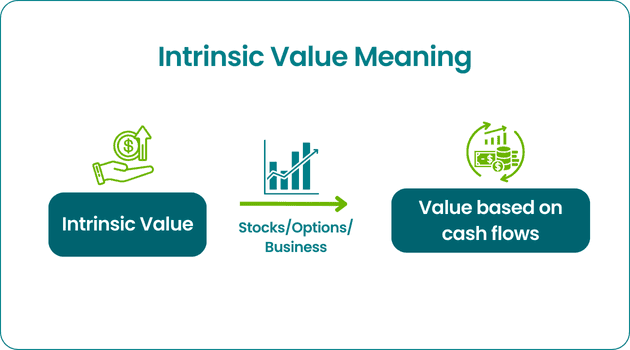Table Of Contents
Intrinsic Value Meaning
Intrinsic value can be defined as the present value of a stock or a business based on cash flows and not the current market price. Many complex mathematical and financial calculations are used to compute the value. This method can be used as an estimate in decision-making.

Usually, both fundamental and technical analysis is used to determine the value. It depends on the actual financial performance of the asset or business. Both qualitative and quantitative factors affect its value. One of the main metrics used here is the discounted cash flow method.
Key Takeaways
- A stock or company's intrinsic value is determined based on cash flows. It varies from other methods because it does not consider the actual cost of the investment or business. Hence it is different from the fair value and market value of assets.
- There are many methods of intrinsic valuation, the most common one being discounted cash flow method. Other methods include the dividend discount, residual income, and Gordon growth models.
- One can calculate the intrinsic value easily by using the formula, online calculator tools, or even by using excel.
Intrinsic Value Explained
Intrinsic value is one of the many financial valuations of an asset or business. Financial analysts use it to make buying-selling or investing decisions. It can be extended to find the value of options too.
Intrinsic valuation involves both technical and fundamental analysis of a company's financials. But quantitative factors will not be sufficient to evaluate a company, and qualitative factors are important too.
For example, if a company makes $5 million in profits every month but is known to conduct illegal activities, the purely quantitative valuation might be in question.
But this type of valuation has some disadvantages too. First, it might downplay the risk element involved in cash flows. Second, it considers many assumptions. Hence, it might become subjective. Lastly, when it comes to options, it might be an incomplete valuation, as it fails to consider the premium and time value of money.
Intrinsic Value - Explained in Video
Calculate Intrinsic Value
Let's look at the calculation of the intrinsic value of stock and options. Given below are the respective formulas.
1. Intrinsic Value for Stock
The discounted cash flow (DCF) or the net present value (NPV) method is the most widely used method.
Value= CF1/(1+i)1 + CF2 /(1+i)2 +............+ CFn /(1+i)n
Where,
- CF is the annual cash flow.
- n is the number of years.
- i is the interest or discount rate.
The same method finds application in the context of a business too.
Calculation:
A firm's earnings per share (EPS) for the past four years is $100. The interest rate is 9%.
Value = 100/(1.9)1 + 100/(1.9)2 + 100/(1.9)3 + 100/(1.9)4
= 52.63 + 27.7 + 14.57 + 7.67
= $102.57
2. Intrinsic Value for Options
Value In the money = | C-S | = | S-C |
Where,
- C is the current price of the options.
- S is its strike price.
Value Out of the money = 0
Calculation:
The current price of an option is $2.3, and its strike price is $1.2. Hence,
Value = |2.3 – 1.2| = $1.1
It is also possible to use an intrinsic value calculator to determine the value easily.
Example
Recently, Yahoo Finance estimated that the shares of the Walt Disney Company could be approximately 47% below the intrinsic value. The article published the step-by-step procedure to find the value through the DCF method.
The company's fair value was $219.26, whereas the current price was $116.41. This shows that the share is undervalued by 46.9%.
Intrinsic Value vs Fair Value
Fair value can be referred to as the worth of an asset. It is the price at which the buyer buys the asset from the seller. The supply-demand conditions, company financials, market conditions, etc. decide the fair value.
It is also important to mention the market value or price. The market value is more or less fair, provided the market forces act strongly on the pricing. Though most factors affecting the intrinsic and fair value might be the same, the main difference is in the valuation method. Most investors and analysts often end up considering both valuations in decision-making.

